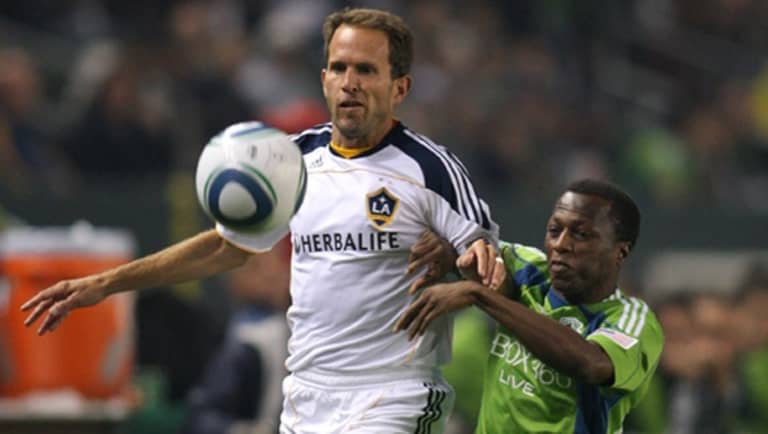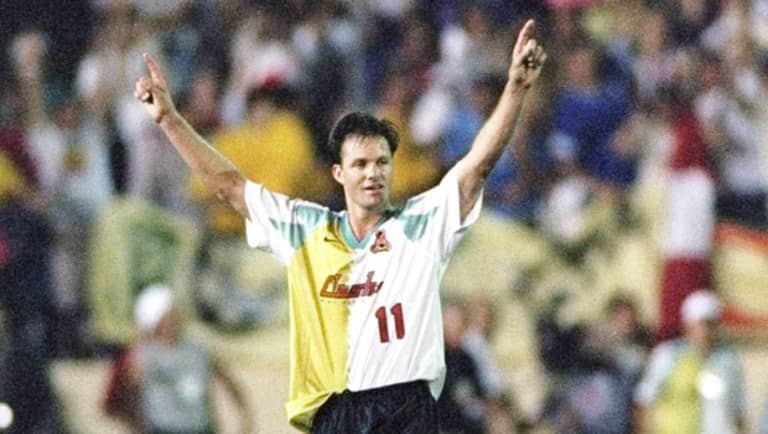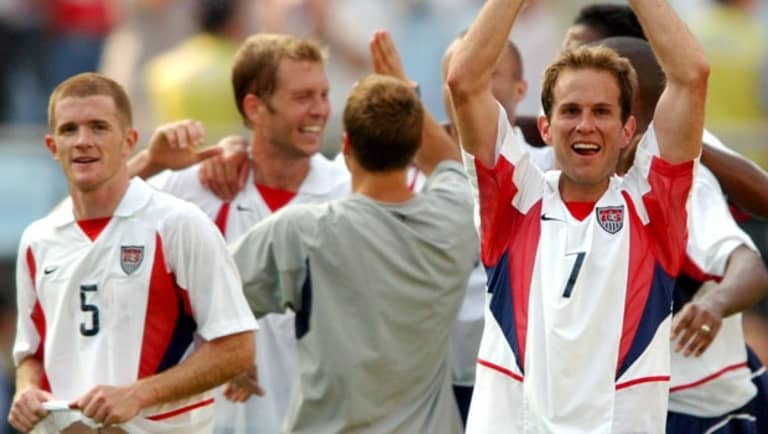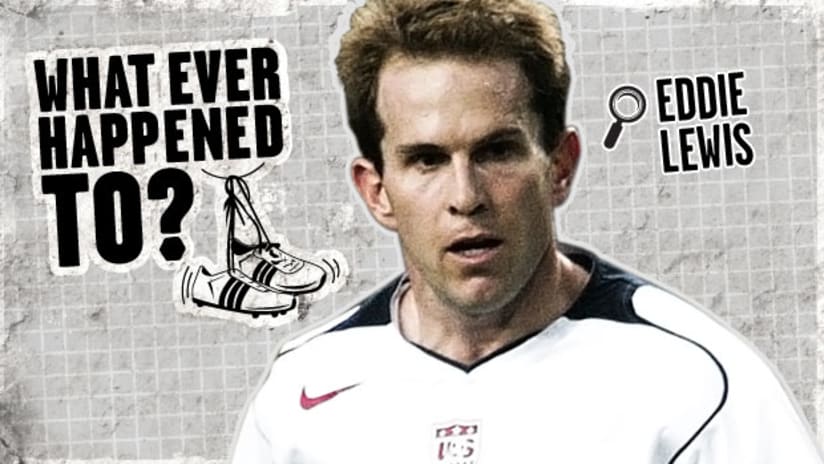MLSsoccer.com continues its look back at the stars, personalities and cult heroes who made Major League Soccer what it is today. Our fourth annual “What Ever Happened To..." series rolls on with 2002 World Cup star and former San Jose Clash and LA Galaxy wing ace Eddie Lewis. (Check out more from the series here.)
Where He Was Then
In the earliest days of Major League Soccer, Eddie Lewis was a check-your-program kind of player. He’d escape from a tight spot on the left wing, or swing in an inch-perfect cross to one of his San Jose Clash teammates, and fans would wonder, Who is that?

Their program would tell them that the crafty No. 21 was Lewis, 1995 graduate of UCLA and relatively unheralded third-round selection (23rd overall) in the ’96 college draft.
By 1999, though, no one needed the program anymore: Lewis was an MLS Best XI selection who’d racked up 14 assists and four goals for the Clash that year, and had become a regular on the US national team. He jumped to Europe in 2000, spending time with Fulham, Preston North End, Leeds (where he was the fans’ Player of the Year in 2006-07), and Derby County before returning to MLS with the LA Galaxy in 2008 and playing three more seasons.
He also appeared in the 2002 and 2006 World Cups, pinpointing a cross to Landon Donovan for the insurance goal in the US’s historic dos a cero Round-of-16 victory over Mexico in ’02.
Where He Is Now
How Lewis made it from “good college player” to “World Cup hero” informs what he’s up to today.
“As a player, I found it difficult to improve dramatically outside of a normal team training session,” Lewis recalls. “I didn’t feel that a player should be limited to their exposure to the team and the team’s training.”
Looking for a way to get better, he turned to good ol’ Yankee ingenuity.
His former teammate Jimmy Conrad picks up the story: “I used to see him training with a tennis-ball machine, having it shoot tennis balls at different trajectories and then volleying them or settling them, with his feet, on the tennis court. I asked him about it, and he was a little guarded at first, kind of protecting the ‘secret sauce,’ but he eventually told me what it was all about.”
What They Said

"As a forward who was starting to get frustrated at making runs and not getting very good service at the beginning of MLS, his arrival [in the San Jose lineup] was pretty cool. It made me smile because I was like, 'Man this guy can play.'
"He’s got an unbelievable left foot – he’ll put the ball on your eyebrow, if you want him to. His contribution at both the club level and the national team was significant because it’s something that this country has always lacked. We’ve never really had a lot of left-footed players who bring something to the table.
"Eddie’s just a phenomenal soccer player, and I don’t think we’ve been able to find his equal, since his departure, as far as left-footed players are concerned.”
– Eric Wynalda, former San Jose & US teammate
While at UCLA, Lewis had watched the Bruins’ basketball team practicing three-point shots into a rim with a smaller circumference, and it had been a light-bulb moment for him.
So he used the “small ball” individual training routine on his own time during his three years in San Jose, getting repetitive, targeted work to improve his technical ability – and seeing results.
Conrad started using the method, too.
“A regular ball seemed like a balloon,” after sessions with the tennis-ball machine, he says.
(Coincidentally or not, Conrad also went on to become a decorated MLS player, a US national teamer, and a World Cup veteran.)
Today, Lewis has transformed his improvised training method into TOCA, a patented machine that can deliver soccer balls at varying speeds, trajectories, and intervals. (Check it out at tocafootball.com and watch videos of the machine on the company's YouTube channel.)
The concept is the same, but a tennis-ball machine this is not: TOCA can hold 50 soccer balls at a time (it uses size 2s and 3s, so the small-ball concept is intact), and it comes with a smart device and software that allows you to program the flight of each individual ball the machine launches.
“You can set it for a very consistent set of exercises,” Lewis says, “or an intricate array of them, with different deliveries.”
The entire system is cloud-based, and can give feedback on a number of different metrics after every session.
“To me, it’s a much more efficient way to address what are critical standards in the game, but very difficult to acquire,” Lewis says.
He envisions a day, in the not-too-distant future, when every soccer complex will be equipped with a dedicated technical area, much like baseball fields have batting cages and pitching machines.
“In baseball, it’s not a competitive advantage to have a pitching machine. It’d be a disadvantage if you didn’t,” he says.
Lewis is “certain” the same will apply to soccer before long – and TOCA will be well positioned for that development.
When he’s not tending to all matters TOCA, Lewis spends time with his wife and three kids, Giselle, 12, James, 9, and Callen, 7. They were all born in England but have managed to adjust from the rain and fog of their birthplace to the sun and beaches of Southern California.
Lewis remembers the US win over Mexico in the 2002 World Cup “as the pinnacle of my career – not just because it was a big moment and I was a part of it, but because of all of the other things outside of being on that field. We were so committed to continuing to drive the American [soccer] reputation, and it was our biggest rival, on the biggest stage, in the biggest moment.”

As for his deadly cross to Donovan for the second goal, he says, “As soon as that pass from John O’Brien came in and my first touch settled the ball, it was almost as if it the goal was already kind of going in. The space was there, Landon was running, I knew where I needed to put the ball, I had enough time, and it was just one of those – it was already going in.
“It was a great goal and it signified everything that we were trying to achieve, which was, this game’s over – we knew it, Mexico knew it, the world knew it. We just went up another level; we were going into uncharted territory.”
The former Clash and Galaxy winger still follows MLS fairly closely, and he remembers his two stints in the league fondly, from changing in a “double-wide trailer” with San Jose in the early days to the LA’s current “great setup” in Carson, Calif.
The Clash team he played on included a number of notable players, from Eric Wynalda and Ronald Cerritos to current Timbers coach Caleb Porter and US national team assistant Martin Vasquez.
Lewis was on the sidelines, about to enter the first game in MLS history, when Wynalda nutmegged D.C. United defender Jeff Agoos and curled a shot into the far corner for the league’s historic first goal, which gave the Clash a 1-0 win.
If you look at the highlight, Lewis recalls, “There’s this one clown bouncing up and down on the sidelines, happier than anybody else in the stadium.”
That’d be the normally reserved Lewis, and his emotions were equal parts joy and relief.
“Because I knew at that point that we would probably win the game [in regulation] and I wouldn’t have to do the breakaway shootout they had in the league at that time,” he says. “We’d been practicing them, and I was terrible.”













